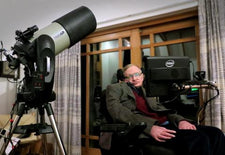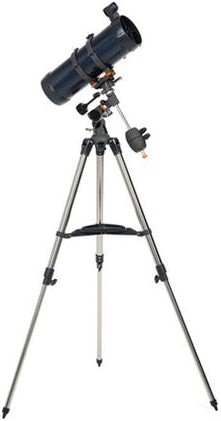How to Buy Your First Telescope - Part 2
August 11, 2015

Part Two: Refractors, Reflectors and Catadioptrics Demystified
There are three basic types of telescopes: refractors, reflectors, and catadioptrics. All three designs have the same purpose, to collect light and bring it to a point of focus so it can be magnified with an eyepiece for examination by the eye. Each does this work differently, though. And each design has its advantages and disadvantages.
Refractor Telescopes
A refractor is what the average person imagines when they hear the word "telescope." The refractor’s signature long, narrow tube carries light in a straight line from the front (objective) lens to the rear-mounted eyepiece. Many serious amateur astronomers swear by their high-end refractors because they provide excellent, high-contrast views. Refractors truly excel when viewing the Moon, planets, and double stars. Another nice feature of refractors is that they provide correctly oriented images, making them suitable for daytime use. If you have a balcony or home with a nice view, you can use your refractor during the day to view wildlife or boats on the water.


A refractor’s objective lens is secured to the telescope tube by its outer edges. When the lens gets too large or heavy, it becomes difficult to keep stable. For this reason, the price of a refractor quickly goes up as its aperture increases. In fact, refractors are the most expensive telescope design per inch of aperture.
Additionally, larger refractors (over 100mm or so) can be quite unwieldy. Their long tubes and optical elements make them delicate and heavy. Hundreds of years ago, telescope makers sought to create a more compact, durable telescope by replacing lenses with mirrors, thus “folding” the light path and allowing the optical elements to be secured in place. The result was our second optical design, the reflector.
Reflecting Telescopes
Newtonian reflectors use mirrors, not lenses, to gather and focus light to form an image. When you first see a reflector, you might be surprised that the eyepiece is up at the top end of the tube, not at the bottom like a refractor. This is because light travels down into the tube, strikes the primary mirror, and then bounces off a tilted secondary mirror, which directs it into the eyepiece. Some observers find that having the eyepiece at the top of the tube makes viewing through a reflector more comfortable, especially when objects are directly overhead. Reflectors are great for all-around viewing, but their wide field of view makes them ideal for observing deep sky objects like nebulae and open star clusters. Reflectors are not suited to terrestrial or land-based viewing.


When comparing reflectors, pay attention to the type of primary mirror they contain. Entry-level reflectors sometimes use a spherical mirror, which can produce a visual defect called spherical aberration. To correct for this, manufacturers will add additional optical elements to the focuser, which can dim overall image brightness. If you have the choice, we recommend spending a little more for a telescope with a parabolic mirror, which does not suffer from this defect. You’ll get sharp views and maximize the brightness of your image.
A reflector’s mount is also an important detail to consider. Of course, reflectors come on traditional tripod mounts—both computerized and non-computerized. But this optical design is also available on a unique telescope mount called a Dobsonian. These (usually wooden) rocker-box style mounts resemble a lazy susan. The telescope sits on the ground or a tabletop and the user pushes the tube to point to the desired target in the night sky. Dobsonians are simple, intuitive, and usually offer the most aperture-per-dollar of any telescope design.
With all reflectors, keep in mind that the open optical tube can leave your telescope’s mirrors vulnerable to dust. Make sure to use the provided lens caps when storing and transporting your telescope.
Schmidt-Cassegrain Telescopes and Other Catadioptrics
So far, we’ve discussed telescopes that use mirrors or lenses to produce an image. In the 1970s, a new telescope design skyrocketed to popularity, the Schmidt-Cassegrain. This hybrid design includes both mirrors and lenses. Schmidt-Cassegrains are the most compact and durable telescopes, and their visual performance can rival even top-end refractors.
 In a catadioptric telescope like the Schmidt-Cassegrain or its cousin the Maksutov-Cassegrain, light first passes through a corrector lens on the outer edge of the telescope tube, either a Schmidt or Maksutov corrector. This thin plate looks like a flat piece of glass to the naked eye, but it has a specific, irregular shape that bends the light to reduce visual defects. After passing through the corrector, the light’s path is similar to that of a reflector: light strikes the primary mirror, then the secondary mirror, and reflects down into the eyepiece.
In a catadioptric telescope like the Schmidt-Cassegrain or its cousin the Maksutov-Cassegrain, light first passes through a corrector lens on the outer edge of the telescope tube, either a Schmidt or Maksutov corrector. This thin plate looks like a flat piece of glass to the naked eye, but it has a specific, irregular shape that bends the light to reduce visual defects. After passing through the corrector, the light’s path is similar to that of a reflector: light strikes the primary mirror, then the secondary mirror, and reflects down into the eyepiece.
Smaller catadioptric telescopes usually use the Maksutov-Cassegrain optical design, while larger scopes use the Schmidt-Cassegrain design. Schmidt-Cassegrains are by far the most popular type of astronomical instrument for serious amateurs, available in sizes up to 14” and larger.


Schmidt-Cassegrain telescopes offer excellent value per dollar. They’re simple enough for beginners to use, but will grow with you in the hobby for years to come. In addition to exploring the Solar System and thousands of deep sky objects, you can use your Schmidt-Cassegrain to capture the Universe with a DSLR or astronomical camera. The possibilities are endless.
We’re Here to Help!
Now that you have read about magnification, aperture, and the different types of telescopes, you can browse our site more informed. The choice of what telescope to buy—or whether to buy one at all—is up to you. Make it based on your individual circumstances and needs. Remember, our entire team at TelescopesPlus.com is here to help! You can always send us an email or contact one of our Telescope Specialists at 1-800-303-5873. We don't just sell telescopes. We're interested in astronomy, and helping others learn more about it. Clear skies and happy stargazing from TelescopesPlus.com!




